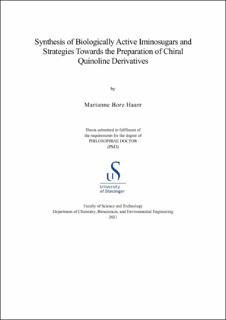| dc.contributor.advisor | Sydnes, Magne Olav | |
| dc.contributor.author | Haarr, Marianne Bore | |
| dc.date.accessioned | 2021-12-02T14:16:02Z | |
| dc.date.available | 2021-12-02T14:16:02Z | |
| dc.date.issued | 2021-12 | |
| dc.identifier.citation | Synthesis of Biologically Active Iminosugars and Strategies Towards the Preparation of Chiral Quinoline Derivatives by Marianne Bore Haarr, Stavanger : University of Stavanger, 2021 (PhD thesis UiS, no. 614) | en_US |
| dc.identifier.isbn | 978-82-8439-043-7 | |
| dc.identifier.issn | 1890-1387 | |
| dc.identifier.uri | https://hdl.handle.net/11250/2832616 | |
| dc.description.abstract | Design and preparation of novel bioactive compounds for development of new drug leads is a challenging task. Chirality plays a key role in all biological systems, including drug targets, and stereoisomeric compounds often have very different pharmacological properties. Chirality is thus an important factor when designing and preparing novel bioactive molecules.
The intention of the first project was to create a library of novel iminosugar antipodes from optically active hexoses for the purpose of glycosidase inhibition testing. The aim of the second project was to synthesize the biologically active martinella alkaloids from prochiral building blocks by installing the stereochemistry with a chiral catalyst, and subsequently create analogues of the alkaloids by altering the side chains connected to the martinella tricyclic scaffold.
In the preparation towards the martinella alkaloids, the governing stereocenter was installed by asymmetric Sharpless epoxidation of a cinnamyl alcohol. The resulting epoxide was successfully obtained in 76% ee. However, upon an ineffective reaction step and numerous efforts to circumvent the problem, the progress towards the martinella alkaloids came to a full stop.
The library of novel iminosugars, namely the functionalized D- and Larabino-pyrrolidines, were prepared and evaluated as glycosidase inhibitors. The D-arabino-hydrazide imide and its N-ethyl congener displayed selective α-mannosidase inhibition in the micromolar range, with inhibition constants Ki = 0.23 μM and Ki = 1.4 μM, respectively. Selective α-mannosidase inhibitors are interesting lead molecules for development of therapeutic compounds, such as anticancer and antiviral agents. | en_US |
| dc.language.iso | eng | en_US |
| dc.publisher | University of Stavanger, Norway | en_US |
| dc.relation.ispartofseries | PhD thesis UiS; | |
| dc.relation.ispartofseries | ;614 | |
| dc.relation.haspart | Paper 1: Haarr, M.B., Lopez, O., Pejov, L. et al. (2020) 1,4-Dideoxy-1,4-imino‑D‑arabinitol (DAB) Analogues Possessing a Hydrazide Imide Moiety as Potent and Selective α‑Mannosidase Inhibitors. ACS Omega, 5, 18507. DOI: 10.1021/acsomega.0c02466 | en_US |
| dc.relation.haspart | Paper 2: Haarr, M.B., Sydnes, M.O. (2021) Synthesis of the Hexahydropyrrolo-[3,2-c]-quinoline Core Structure and Strategies for Further Elaboration to Martinelline, Martinellic Acid, Incargranine B, and Seneciobipyrrolidine. Molecules, 26, 341. DOI: 10.3390/ molecules26020341 | en_US |
| dc.relation.haspart | Paper 3: aarr, M.B., Lopez, O., Fernández-Bolanõs, J.G. et al. Functionalized D- and L-Arabino-Pyrrolidines as Potent and Selective Glycosidase Inhibitors. Manuscript in progress. This paper is not available in Brage. | en_US |
| dc.subject | kjemi | en_US |
| dc.subject | chemistry | en_US |
| dc.title | Synthesis of Biologically Active Iminosugars and Strategies Towards the Preparation of Chiral Quinoline Derivatives | en_US |
| dc.type | Doctoral thesis | en_US |
| dc.rights.holder | ©2021 Marianne Bore Haarr | en_US |
| dc.subject.nsi | VDP::Matematikk og Naturvitenskap: 400::Kjemi: 440 | en_US |
